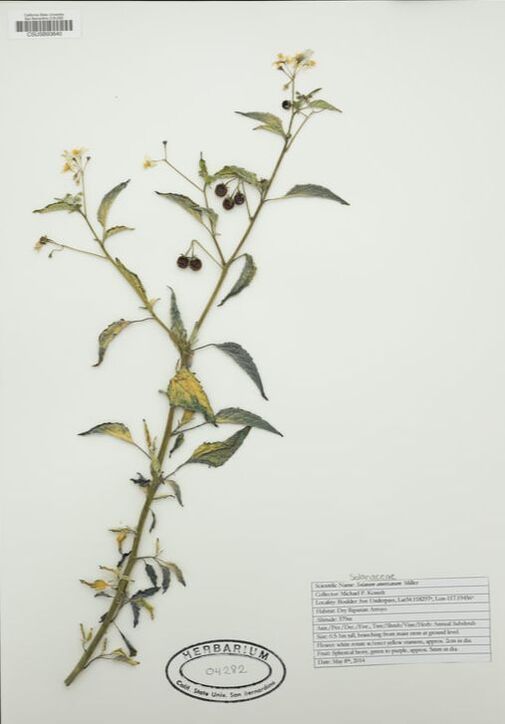If you've been on Twitter during this holiday season, you might have caught wind of the #plantsgiving challenge: a friendly competition to see who can feature the most plant species on their Thanksgiving table. The record currently stands at 66 plant species in one meal (!).
The diversity of plants used for human food is dazzling--from wheat, apples, and carrots to thyme, bay leaves, and black pepper--but this variety scarcely compares to uncultivated diversity. Today, we give thanks not only for the plant species on our Thanksgiving tables, but also the evolutionary relatives of these species, particularly those found in California. Here are a few fun examples:
The diversity of plants used for human food is dazzling--from wheat, apples, and carrots to thyme, bay leaves, and black pepper--but this variety scarcely compares to uncultivated diversity. Today, we give thanks not only for the plant species on our Thanksgiving tables, but also the evolutionary relatives of these species, particularly those found in California. Here are a few fun examples:
Mashed potatoes - Solanum
Despite being a staple of many Eurasian diets, potatoes originated from the Americas (the specimen on the left was collected from Bolivia!) and were spread widely in cultivation. The potatoes we eat are the species Solanum tuberosum. Interestingly, this plant genus, Solanum, is an enormous group of over 1500 species, including the species that give us tomatoes and eggplants. Outside of cultivation, Solanum species are widespread and often weedy. Take for example the California native shown above and to the right, Solanum americanum (American black nightshade). This species thrives in disturbed places and has become a frequent weed in tropical and subtropical places across the globe. Far from mild nature of the potatoes we eat, American black nightshade is, like many of its relatives, poisonous at certain times in its development, but don't let that stop you from dipping into the mashed potatoes! The poison found in nightshade plants, called solanine, doesn't reach dangerous levels in mature tubers (aka potatoes) of Solanum tuberosum.
Green beans - Phaseolus
| Bean-producing plants are so special they have their own family. Ok, it's a really big family with over 19,000 species, but that's just how important beans are to the plant diversity of the world. There are over 300 species in the bean family (Fabaceae) native to California, but only one of them is in the same genus as green beans. The green beans you generally find in soups and casseroles are from the species Phaseolus vulgaris (vulgaris means "common" in Latin). The single native Phaseolus species in California is the slender-stem bean, Phaseolus filiformis. Unlike American nightshade, slender-stem bean is neither common nor widespread in California; only one California specimen has been documented to date! This sand-loving species extends into Arizona, New Mexico, Texas, and Mexico, inhabiting desert washes and producing tiny pink flowers around this time of year. There's little information about whether this species is edible (likely not), but even if it were, we should be mindful of not harming the rare California populations of this species. |
Pumpkin pie - Cucurbita
Don't leave without dessert! The last genus for today includes the famous pumpkin. Whether for carving, artful decoration, pie, or lattes, the pumpkin is a staple of autumn festivities in the U.S. The pumpkin genus, Cucurbita, contains several species of gourds and melons, each with a distinctive fleshy fruit called a pepo. Fittingly, Cucurbita pepo is the species of pumpkin we generally consume during the fall season. (Cultivars of C. pepo are also responsible for zucchini, acorn squash, and summer squash, but let's leave the wonders of artificial selection to a future blog post.)
The specimen on the left is a pumpkin (C. pepo) that escaped cultivation due to flooding, deemed a waif by the collector. On the right is an established California native, Cucurbita palmata, also known as coyote melon or coyote gourd. This species occurs in southern California, especially in hot, arid areas. As demonstrated above, C. palmata shares similar morphology and habit to the familiar pumpkin; its stiff-haired vines and tendrils crawl across the ground, and it produces coarse, hairy leaves and the distinctive pepo fruit. Unfortunately, coyote melon does not share the rich, tasty flavor of our beloved field pumpkins, but that doesn't stop a variety of moth species from feasting on the plant, despite its distasteful hairs.
What species do you find on your Thanksgiving table, and do these species have native relatives in your area? Answers to these questions and many more are aided by our knowledge of biodiversity from herbarium specimens.
What species do you find on your Thanksgiving table, and do these species have native relatives in your area? Answers to these questions and many more are aided by our knowledge of biodiversity from herbarium specimens.
Glossary
- genus - scientific name that denotes a rank above species but below family
- habit - the general architecture or form in which a plant grows (e.g., tree, shrub, vine)
- morphology - appearance and appearance-related traits (e.g., leaf shape, color)
- pepo - a type of fleshy fruit with a tough rind, produced by a species of the melon family
- tuber - an underground stem or rhizome that is enlarged and thickened, usually for storage of starch and minerals for the plant
- waif - plant occurring outside of its usual range or circumstances that is not likely to persist









